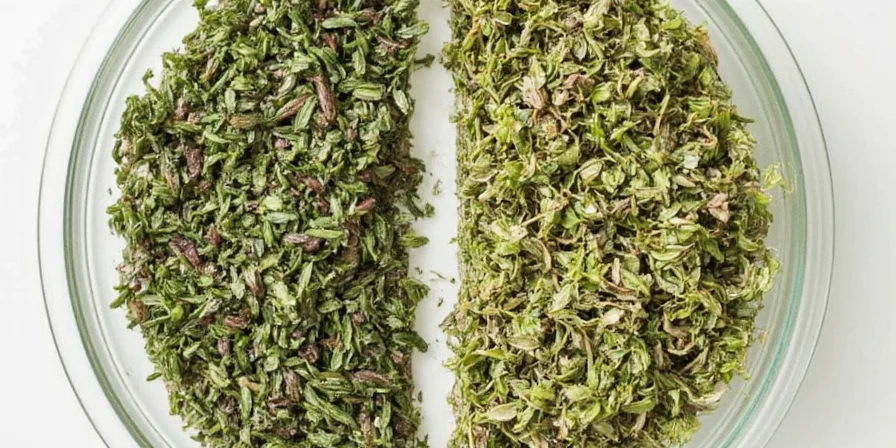1 tablespoon fresh thyme = 1/3 teaspoon dried thyme - this precise conversion ratio solves the most common seasoning dilemma for home cooks. Get the exact measurements chefs use, avoid over-seasoning disasters, and achieve perfect flavor balance in every dish with this science-backed reference guide.
Quick-Reference Conversion Chart
| Fresh Thyme Measurement | Dried Thyme Equivalent |
|---|---|
| 1 tablespoon chopped fresh leaves | ⅓ teaspoon dried |
| 1 sprig (3-inch stem) | ¼ teaspoon dried |
| 1 cup loosely packed fresh (8g) | 1½ tablespoons dried (2.5g) |

Why the 3:1 Ratio Works: Flavor Science Simplified
Fresh thyme contains 85% water that dilutes flavor compounds. When dried, water evaporates while oil-soluble compounds like thymol concentrate, creating earthier notes. This explains why 1 tablespoon fresh thyme equals 1/3 teaspoon dried thyme - dried delivers 200-300% more concentrated flavor per volume.
- Fresh thyme provides bright, grassy top notes (add in last 5 minutes of cooking)
- Dried thyme offers deep, resinous base notes (add at cooking start for stews)

Critical Conversion Adjustments by Dish Type
Standard ratios fail without these recipe-specific tweaks. Save this chart for perfect seasoning every time:
| Dish Type | Adjustment | Example |
|---|---|---|
| Delicate dishes (fish, custards) | Use 25% less dried thyme | 1 tbsp fresh = ¼ tsp dried |
| High-heat roasting (375°F+/190°C+) | Increase dried by 15% | 1 tbsp fresh = ⅜ tsp dried |
| Slow-cooked stews | Use full conversion ratio | 1 tbsp fresh = ⅓ tsp dried |
Pro tip: Always bloom dried thyme in 1 tsp oil over low heat for 60 seconds before adding liquids to prevent dusty texture.

When to Use Each Type: Quick Decision Guide
Match your herb form to cooking method for perfect results:
- Use fresh thyme when: Making salad dressings, finishing dishes, or cooking quick sauces (add in last 5 minutes)
- Use dried thyme when: Creating dry rubs, baking savory goods, or cooking stews (add at beginning)
Never substitute dried for fresh in cold applications - dried thyme's concentrated tannins create bitterness in salad dressings and cold sauces.

Storage Hacks That Preserve Flavor
Extend shelf life with these science-backed techniques:
- Fresh thyme: Store upright in 1" water covered with perforated bag (lasts 21 days)
- Dried thyme: Use amber glass containers with oxygen absorbers (not silica gel)
- Revive stale thyme: Toast 30 seconds in dry skillet to reactivate oils

Pro Techniques for Flavor Perfection
Implement these chef secrets for restaurant-quality results:
- Simmer woody stems in stock for 30 minutes before discarding to extract hidden flavors
- Add fresh thyme at 160°F (71°C) to preserve volatile compounds without bitterness
- Use 70% dried thyme at start + 30% fresh at finish for dimensional flavor
- Counter dried thyme's tannins with sherry vinegar in braises for rounded flavor
- Pair dried thyme with allspice in jerk rubs to amplify earthy notes (Caribbean technique)

Most Common Questions Answered
Can I substitute dried thyme for fresh in salad dressings?
No—dried thyme's concentrated tannins create bitterness in cold applications. Always use fresh thyme for dressings, adding it after emulsification to preserve volatile compounds.
Why does my dried thyme taste dusty in soups?
This occurs when dried thyme isn't bloomed. Always sauté it in 1 tsp oil for 60 seconds before adding liquids to rehydrate flavor compounds and eliminate granular texture.
How do I adjust conversions for lemon thyme?
Lemon thyme requires 20% less dried equivalent due to higher moisture content. Use 1 tbsp fresh lemon thyme = ¼ tsp dried for balanced citrus notes.
Key Takeaways
Remember these three rules for perfect thyme substitutions: 1. 1 tablespoon fresh thyme = 1/3 teaspoon dried thyme (standard ratio) 2. Never use dried thyme in cold applications - it creates bitterness 3. Always bloom dried thyme in oil before adding to liquids By implementing these precise conversions and techniques, you'll eliminate flavor inconsistencies and achieve restaurant-quality seasoning in every dish. The key is understanding that fresh thyme provides bright top notes while dried thyme delivers foundational earthiness - using them strategically creates multidimensional flavors.












 浙公网安备
33010002000092号
浙公网安备
33010002000092号 浙B2-20120091-4
浙B2-20120091-4